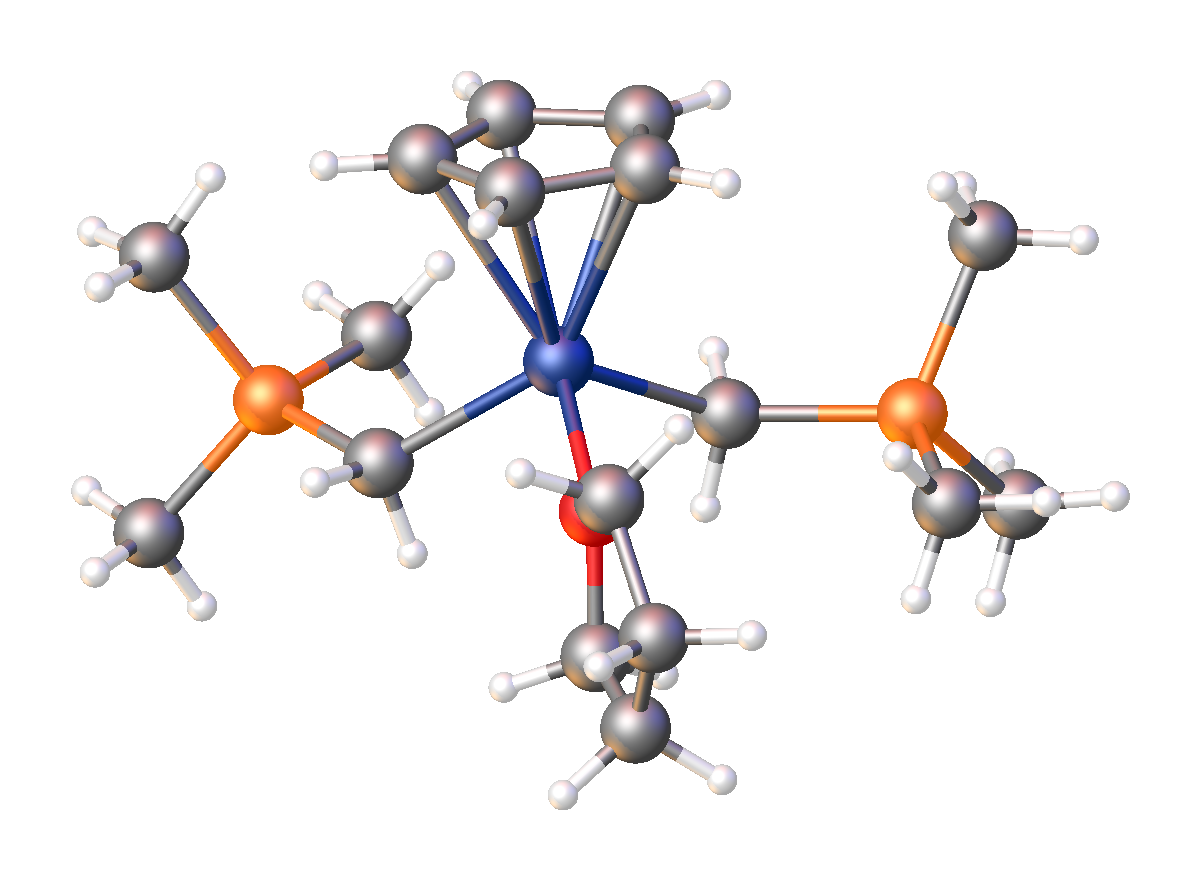Organoscandium chemistry on:
[Wikipedia]
[Google]
[Amazon]
 Organoscandium chemistry is an area with
Organoscandium chemistry is an area with
 Organoscandium chemistry is an area with
Organoscandium chemistry is an area with organometallic compounds
Organometallic chemistry is the study of organometallic compounds, chemical compounds containing at least one chemical bond between a carbon atom of an organic molecule and a metal, including alkali, alkaline earth, and transition metals, and so ...
focused on compounds with at least one carbon
Carbon () is a chemical element with the symbol C and atomic number 6. It is nonmetallic and tetravalent—its atom making four electrons available to form covalent chemical bonds. It belongs to group 14 of the periodic table. Carbon mak ...
to scandium
Scandium is a chemical element with the symbol Sc and atomic number 21. It is a silvery-white metallic d-block element. Historically, it has been classified as a rare-earth element, together with yttrium and the Lanthanides. It was discovered in ...
chemical bond
A chemical bond is a lasting attraction between atoms or ions that enables the formation of molecules and crystals. The bond may result from the electrostatic force between oppositely charged ions as in ionic bonds, or through the sharing of ...
. The interest in organoscandium compounds is mostly academic but motivated by potential practical applications in catalysis
Catalysis () is the process of increasing the rate of a chemical reaction by adding a substance known as a catalyst (). Catalysts are not consumed in the reaction and remain unchanged after it. If the reaction is rapid and the catalyst recyc ...
, especially in polymerization
In polymer chemistry, polymerization (American English), or polymerisation (British English), is a process of reacting monomer molecules together in a chemical reaction to form polymer chains or three-dimensional networks. There are many fo ...
. A common precursor is scandium chloride
Scandium(III) chloride is the inorganic compound with the formula ScCl3. It is a white, high-melting ionic compound, which is deliquescent and highly water-soluble. This salt is mainly of interest in the research laboratory. Both the anhydrous f ...
, especially its THF complex.
As with the other elements in group 3 Group 3 may refer to:
*Group 3 element, chemical element classification
*Group 3 (racing), FIA classification for auto racing
* Group 3, the third tier of races in worldwide Thoroughbred horse racing
* Group 3 image format, Group 3 & Group 4 are ...
– e.g. yttrium
Yttrium is a chemical element with the symbol Y and atomic number 39. It is a silvery-metallic transition metal chemically similar to the lanthanides and has often been classified as a " rare-earth element". Yttrium is almost always found in co ...
, forming organoyttrium compounds – and the lanthanides, the dominant oxidation state
In chemistry, the oxidation state, or oxidation number, is the hypothetical charge of an atom if all of its bonds to different atoms were fully ionic. It describes the degree of oxidation (loss of electrons) of an atom in a chemical compound. C ...
for scandium in organometallic compounds is +3 ( electron configuration r3d14s2). The members of this group also have large ionic radii
Ionic radius, ''r''ion, is the radius of a monatomic ion in an ionic crystal structure. Although neither atoms nor ions have sharp boundaries, they are treated as if they were hard spheres with radii such that the sum of ionic radii of the cation ...
with vacant s,p and d orbitals (88 pm for Sc3+ compared to 67 pm for Al3+) and as a result they behave as hard Lewis acids and tend to have high coordination number
In chemistry, crystallography, and materials science, the coordination number, also called ligancy, of a central atom in a molecule or crystal is the number of atoms, molecules or ions bonded to it. The ion/molecule/atom surrounding the central io ...
s of 9 to 12. The metal to ligand chemical bond
A chemical bond is a lasting attraction between atoms or ions that enables the formation of molecules and crystals. The bond may result from the electrostatic force between oppositely charged ions as in ionic bonds, or through the sharing of ...
is largely ionic.
Illustrative complexes
Sc(III) derivatives
Many organoscandium(III) compounds have at least one cyclopentadienyl-typeligand
In coordination chemistry, a ligand is an ion or molecule ( functional group) that binds to a central metal atom to form a coordination complex. The bonding with the metal generally involves formal donation of one or more of the ligand's elec ...
. The reaction of scandium trichloride with two equivalents of sodium cyclopentadienide
Sodium cyclopentadienide is an organosodium compound with the formula C5H5Na. The compound is often abbreviated as NaCp, where Cp− is the cyclopentadienide anion. Sodium cyclopentadienide is a colorless solid, although samples often are p ...
(NaCp) produces the chloride-bridged dimer:
:2ScCl3 + 4NaCp → p2Sc(μ-Cl)sub>2 + 4NaCl
Cp3Sc is a polymer wherein one third of the Cp ligands serving as bridging ligand
In coordination chemistry, a bridging ligand is a ligand that connects two or more atoms, usually metal ions. The ligand may be atomic or polyatomic. Virtually all complex organic compounds can serve as bridging ligands, so the term is usually ...
s.
Bulkier cyclopentadienide ligands give monoscandium derivatives, e.g. (C5Me5)2ScCl. The corresponding alkyls polymerize alkenes.
The synthesis of a tris(allyl)scandium complex is analogous to the above methods, involving the reaction of ScCl3 with allyl potassium in THF solution, The product is Sc(C3H5)3(THF)2 wherein two allyl ligands are η3 coordinated and one allyl ligand is η1.
Sc(II) and Sc(I) derivatives
Organoscandium compounds in lower oxidation states have been prepared.References
{{ChemicalBondsToCarbon